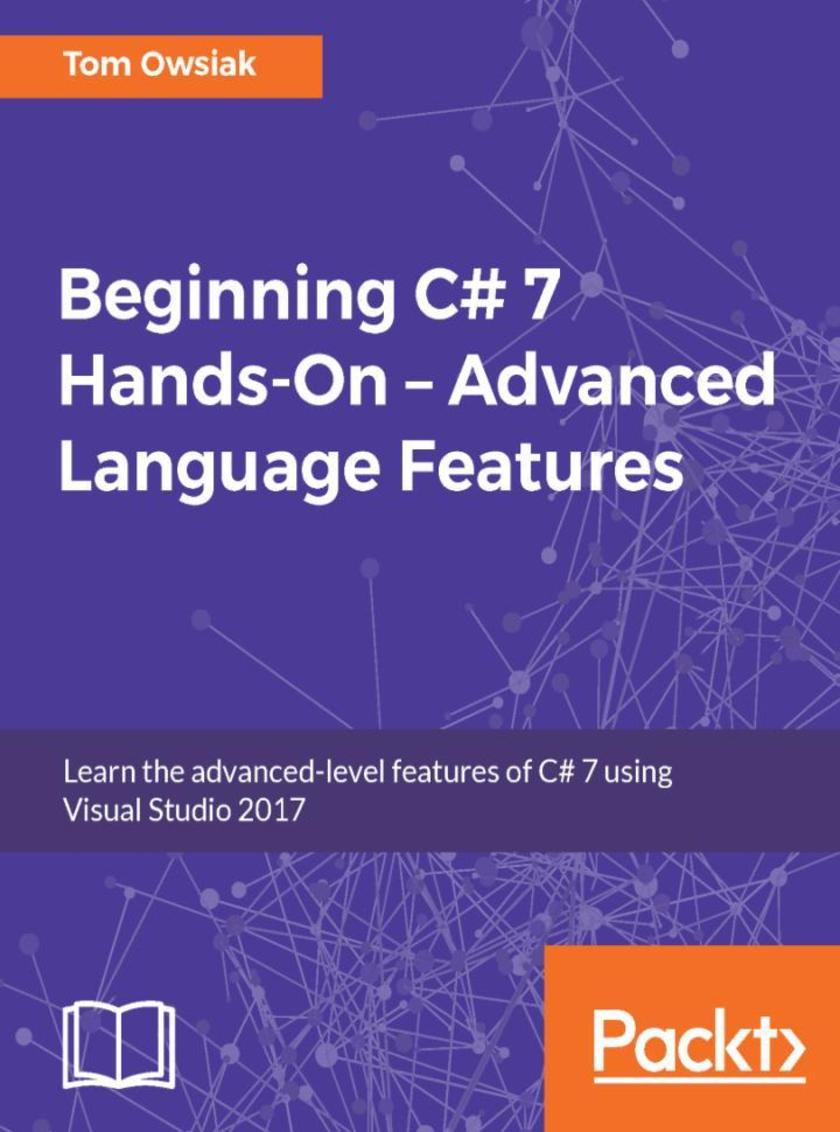
Beginning C# 7 Hands-On – Advanced Language Features
¥71.93
An advanced C# beginners guide to some of the tougher parts of the C# language! About This Book ? Learn C#, Visual Studio, and object-oriented programming ? Get practical examples of advanced C# language features so that you can easily master them yourself ? Use the C# programming language to work generics and lambda expressions ? Program C# and SQL Server 2014 ? Get ready for your first MVC applications Who This Book Is For This book is for anyone who is interested in learning how to program the more advanced aspects of the C# language. Previous programming knowledge of C# is required, at least to the level of basic object-oriented programming. Readers can benefit from first reading Tom Owsiak’s companion book, Beginning C# 7 Hands-On – The Core Language, as a preparation for the more advanced elements and techniques presented in this book. What You Will Learn ? Learn C# advanced language elements and techniques ? Discover advanced C# techniques with hands-on working examples ? Build on your knowledge of OOP by using C# generics and lambda expressions ? Work with C# and LINQ custom data types ? Program C# and SQL Server 2017 to manage and query data ? Create your first full MVC application In Detail Beginning C# 7 Hands-On – Advanced Language Features assumes that you’ve mastered the basic elements of the C# language and that you're now ready to learn the more advanced C# language and syntax, line by line, in a working Visual Studio environment. You'll learn how to code advanced C# language topics including generics, lambda expressions, and anonymous methods. You'll learn to use query syntax to construct queries and deploy queries that perform aggregation functions. Work with C# and SQL Server 2014 to perform complex joins and stored procedures. Explore advanced file access methods, and see how to serialize and deserialize objects – all by writing working lines of code that you can run within Visual Studio. This book is designed for beginner C# developers who have mastered the basics now, and anyone who needs a fast reference to using advanced C# language features in practical coding examples. You'll also take a look at C# through web programming with web forms. By the time you’ve finished this book, you’ll know all the critical advanced elements of the C# language and how to program everything from C# generics to XML, LINQ, and your first full MVC web applications. These are the advanced building blocks that you can then combine to exploit the full power of the C# programming language, line by line. Style and approach A comprehensive book that blends theory with just the right amount of practical code implementations, to help you get up and running with the C# programming language and its advanced features. You’ll also get to work with other tools and technologies that complement C# programming. Each core part of the C# language is coded as you learn, and code output is tested every time to verify the syntax is working as expected, so it’s easy for you to learn directly from the working code examples. Advanced-level features of C# will be used to code and work through examples.
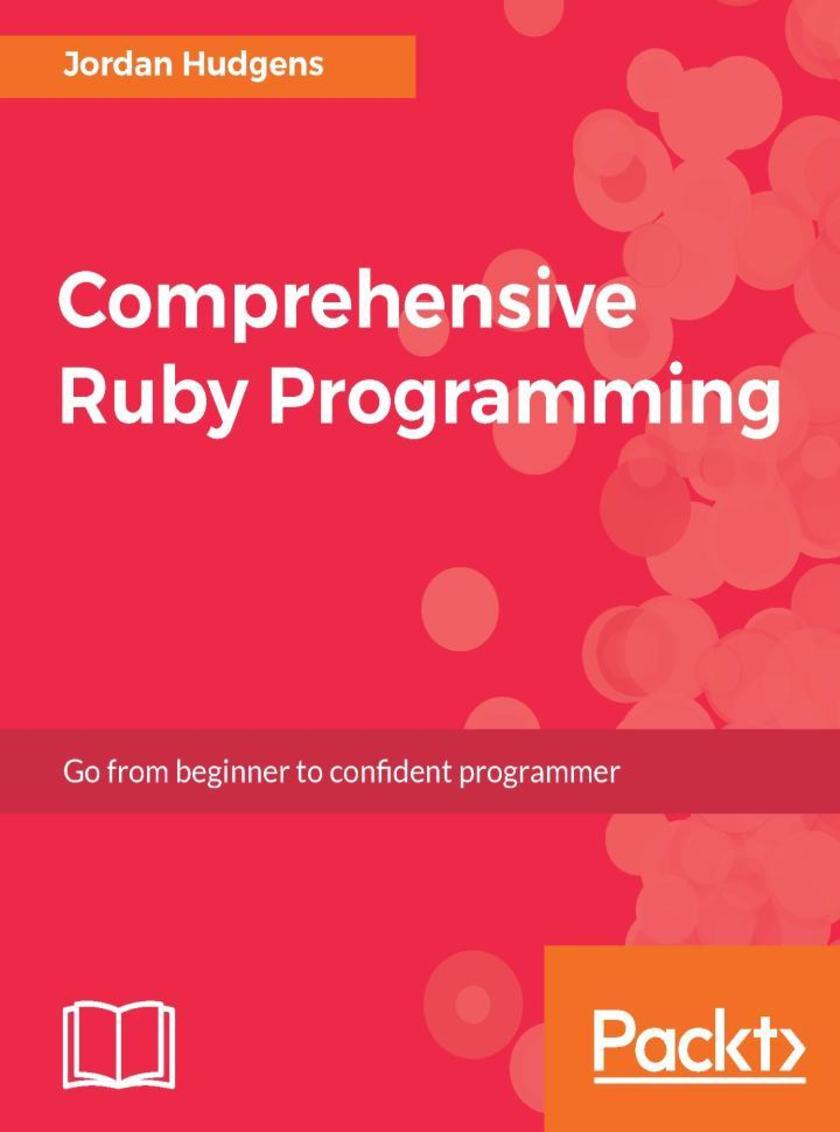
Comprehensive Ruby Programming
¥71.93
This book will provide you with all of the tools you need to be a professional Ruby developer. Starting with the core principles, such as syntax and best practices, and up to advanced topics like metaprogramming and big data analysis. About This Book ? Provides the core skills required to become a Ruby programmer ? Covers how to use the most popular Ruby Gem libraries ? Includes details on regular expressions Who This Book Is For This is a complete course written from the ground up for beginners wanting to gain a solid understanding of the Ruby language. It starts at the beginning with how to install Ruby and work with it on multiple machines, so simply have a computer that's connected to the Internet and you'll be ready. What You Will Learn ? Learn how to use Ruby code effectively, picking the right tool for the job and not duplicating built-in functionality ? Gain best software development practices, and how to identify and fix common errors ? Absorb core programming skills, such as variables, strings, loops, conditionals, and much more ? Explore object-oriented programming and learn to create modular, reusable code that you can use across projects ? Build 10 practical Ruby programs as you work through the book on topics such as big data analysis and solving Euler equations In Detail Ruby is a powerful, general-purpose programming language that can be applied to any task. Whether you are an experienced developer who wants to learn a new language or you are new to programming, this book is your comprehensive Ruby coding guide. Starting with the foundational principles, such as syntax, and scaling up to advanced topics such as big data analysis, this book will give you all of the tools you need to be a professional Ruby developer. A few of the key topics are: object-oriented programming, built-in Ruby methods, core programming skills, and an introduction to the Ruby on Rails and Sinatra web frameworks. You will also build 10 practical Ruby programs. Created by an experienced Ruby developer, this book has been written to ensure it focuses on the skills you will need to be a professional Ruby developer. After you have read this book, you will be ready to start building real-world Ruby projects. Style and approach This is a comprehensive course for learning the Ruby programming language that works methodically through everything that you need to know. It begins with the basics of the language and then works through some complete projects to apply your skills and ensure that you have fully absorbed them and can use them in the real world.
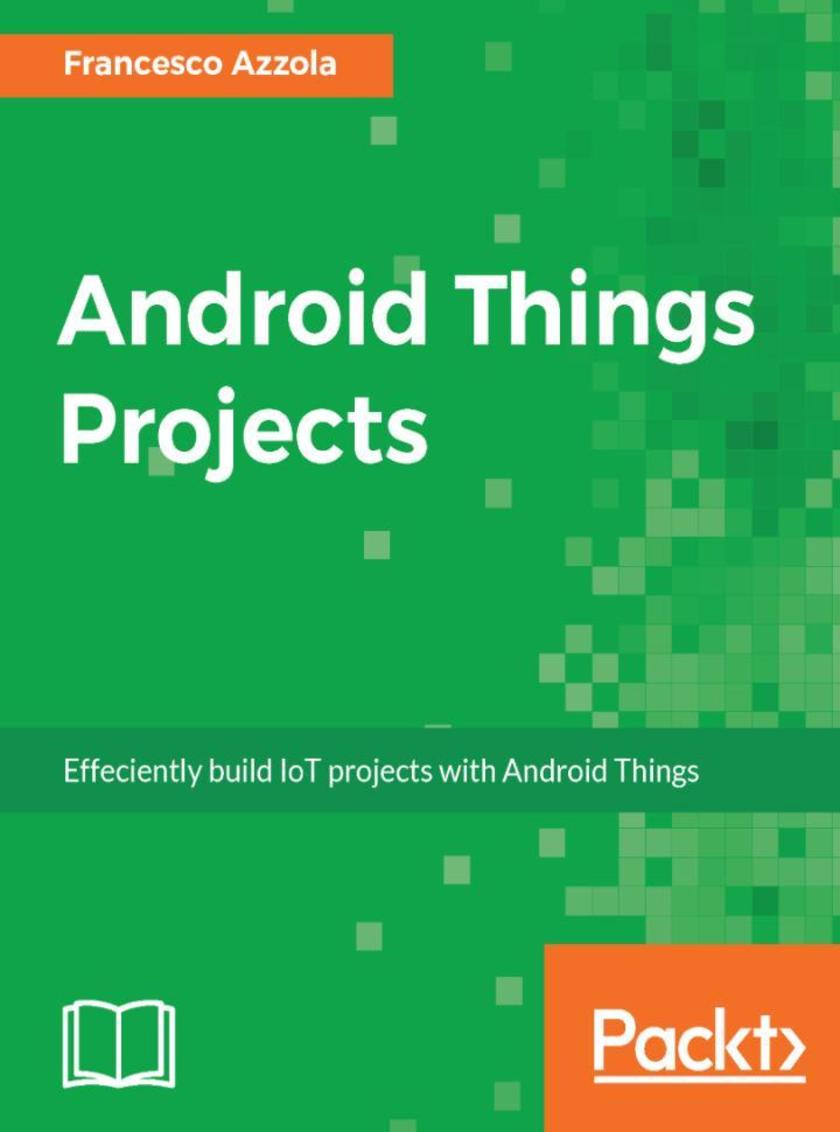
Android Things Projects
¥71.93
Develop smart Internet of things projects using Android Things. About This Book ? Learn to build promising IoT projects with Android Things ? Make the most out of hardware peripherals using standard Android APIs ? Build enticing projects on IoT, home automation, and robotics by leveraging Raspberry Pi 3 and Intel Edison Who This Book Is For This book is for Android enthusiasts, hobbyists, IoT experts, and Android developers who want to gain a deeper knowledge of Android Things. The main focus is on implementing IoT projects using Android Things. What You Will Learn ? Understand IoT ecosystem and the Android Things role ? See the Android Things framework: installation, environment, SDK, and APIs ? See how to effectively use sensors (GPIO and I2C Bus) ? Integrate Android Things with IoT cloud platforms ? Create practical IoT projects using Android Things ? Integrate Android Things with other systems using standard IoT protocols ? Use Android Things in IoT projects In Detail Android Things makes developing connected embedded devices easy by providing the same Android development tools, best-in-class Android framework, and Google APIs that make developers successful on mobile. With this book, you will be able to take advantage of the new Android framework APIs to securely build projects using low-level components such as sensors, resistors, capacitors, and display controllers. This book will teach you all you need to know about working with Android Things through practical projects based on home automation, robotics, IoT, and so on. We’ll teach you to make the most of the Android Things and build enticing projects such as a smart greenhouse that controls the climate and environment automatically. You’ll also create an alarm system, integrate Android Things with IoT cloud platforms, and more. By the end of this book, you will know everything about Android Things, and you’ll have built some very cool projects using the latest technology that is driving the adoption of IoT. You will also have primed your mindset so that you can use your knowledge for profitable, practical projects. Style and approach This book is packed with fun-filled, end-to-end projects that you will be encouraged to experiment on the Android Things OS.
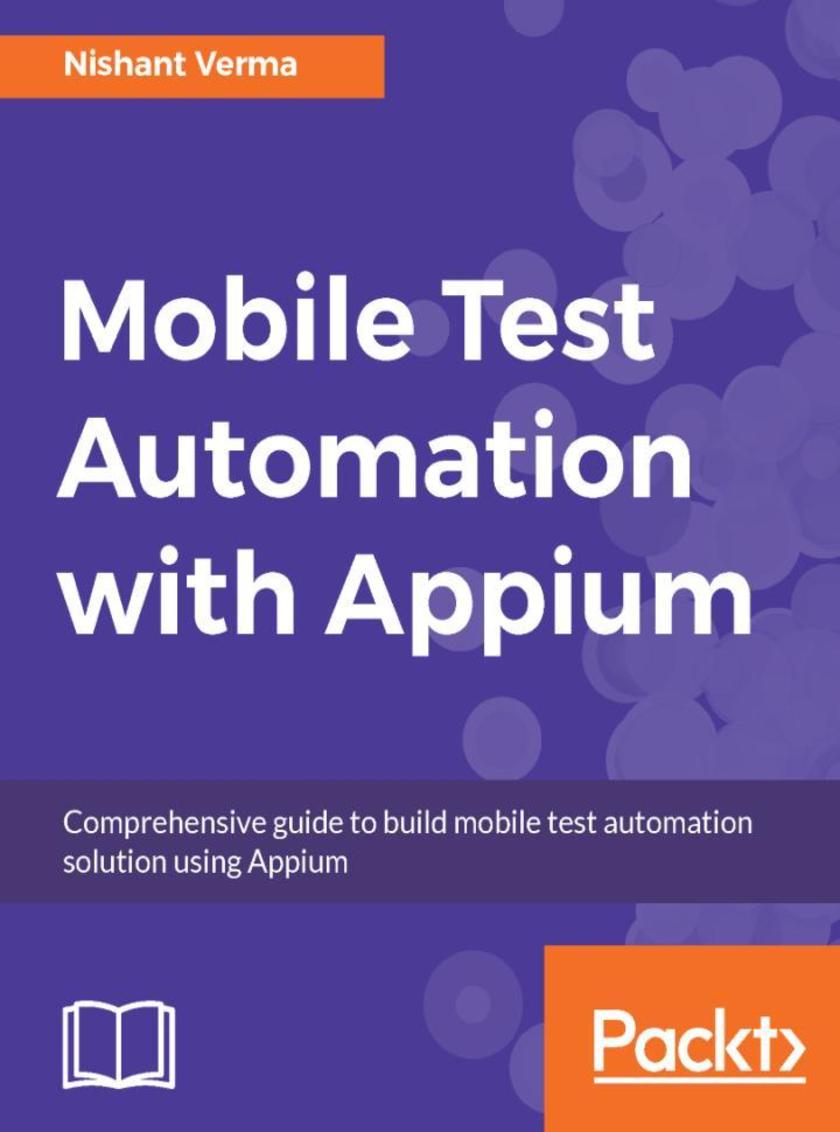
Mobile Test Automation with Appium
¥71.93
Automate your mobile app testing About This Book ? How to automate testing with Appium ? Apply techniques for creating comprehensive tests ? How to test on physical devices or emulators Who This Book Is For Are you a mobile developer or a software tester who wishes to use Appium for your test automation? If so, then this is the right book for you .You must have basic Java programming knowledge. You don’t need to have prior knowledge of Appium. What You Will Learn ? Discover Appium and how to set up an automation framework for mobile testing ? Understand desired capabilities and learn to find element locators ? Learn to automate gestures and synchronize tests using Appium ? Take an incremental approach to implement page object pattern ? Learn to run Appium tests on emulators or physical devices ? Set up Jenkins to run mobile automation tests by easy to learn steps ? Discover tips and tricks to record video of test execution, inter app automation concepts ? Learn to run Appium tests in parallel on multiple devices simultaneously In Detail Appium is an open source test automation framework for mobile applications. It allows you to test all three types of mobile applications: native, hybrid, and mobile web. It allows you to run the automated tests on actual devices, emulators, and simulators. Today, when every mobile app is made on at least two platforms, iOS and Android, you need a tool that allows you to test across platforms. Having two different frameworks for the same app increases the cost of the product and time to maintain it as well. Appium helps save this cost. With mobile app growth exploding, mobile app automation is mainstream now. In this book, author Nishant Verma provides you with a firm grounding in the concepts of Appium while diving into how to set up appium & Cucumber-jvm test automation framework, implement page object design pattern, automate gestures, test execution on emulators and physical devices, and implement continuous integration with Jenkins. The mobile app we have referenced in this book is Quikr because of its relatively lower learning curve to understand the application. It's a local classifieds shopping app. Style and approach This book takes a practical, step-by-step approach to testing and automating individual apps such as native, hybrid, and mobile web apps using different examples.
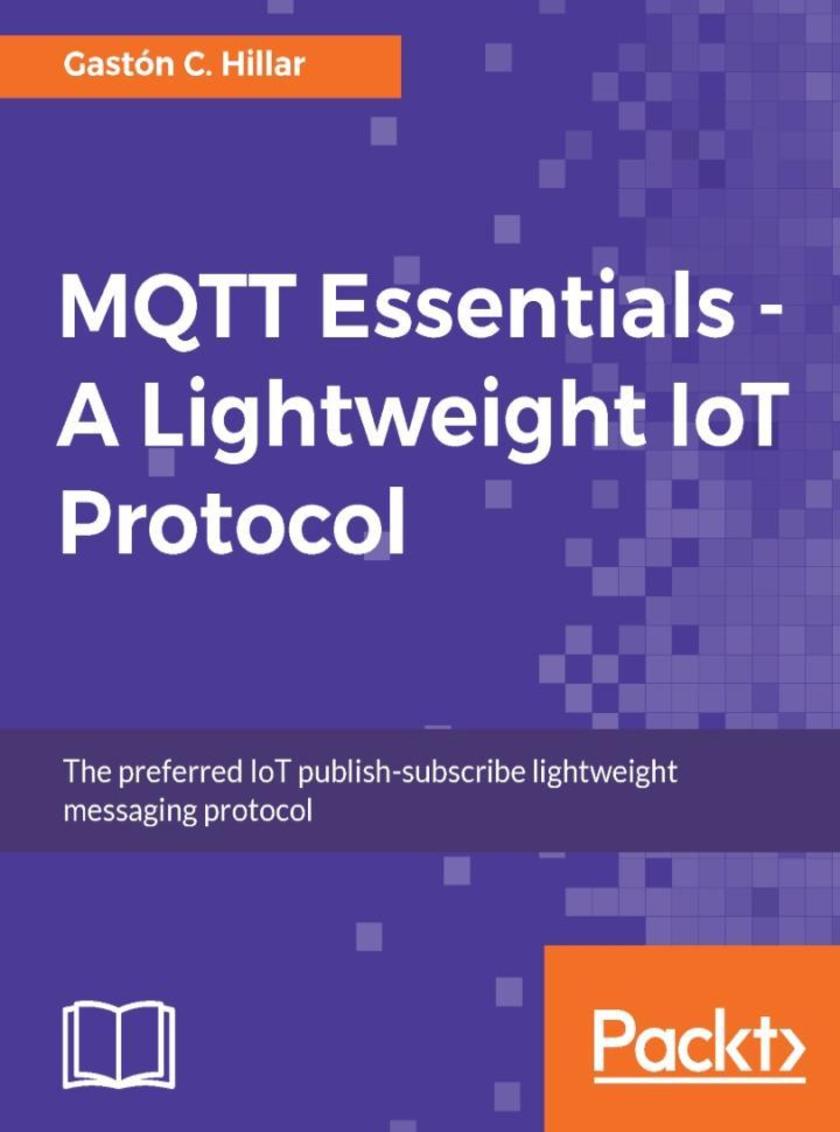
MQTT Essentials - A Lightweight IoT Protocol
¥71.93
This step-by-step guide will help you gain a deep understanding of the lightweight MQTT protocol. We’ll begin with the specific vocabulary of MQTT and its working modes, followed by installing a Mosquitto MQTT broker. Then, you will use best practices to secure the MQTT Mosquitto broker to ensure that only authorized clients are able to publish and receive messages. Once you have secured the broker with the appropriate configuration, you will develop a solution that controls a drone with Python. Further on, you will use Python on a Raspberry Pi 3 board to process commands and Python on Intel Boards (Joule, Edison and Galileo). You will then connect to the MQTT broker, subscribe to topics, send messages, and receive messages in Python. You will also develop a solution that interacts with sensors in Java by working with MQTT messages. Moving forward, you will work with an asynchronous API with callbacks to make the sensors interact with MQTT messages. Following the same process, you will develop an iOS app with Swift 3, build a website that uses WebSockets to connect to the MQTT broker, and control home automation devices with HTML5, JavaScript code, Node.js and MQTT messages What you will learn ?Understand how MQTTv3.1 and v3.1.1 works in detail ?Install and secure a Mosquitto MQTT broker by following best practices ?Design and develop IoT solutions combined with mobile and web apps that use MQTT messages to communicate ?Explore the features included in MQTT for IoT and Machine-to-Machine communications ?Publish and receive MQTT messages with Python, Java, Swift, JavaScript, and Node.js ?Implement the security best practices while setting up the MQTT Mosquitto broker
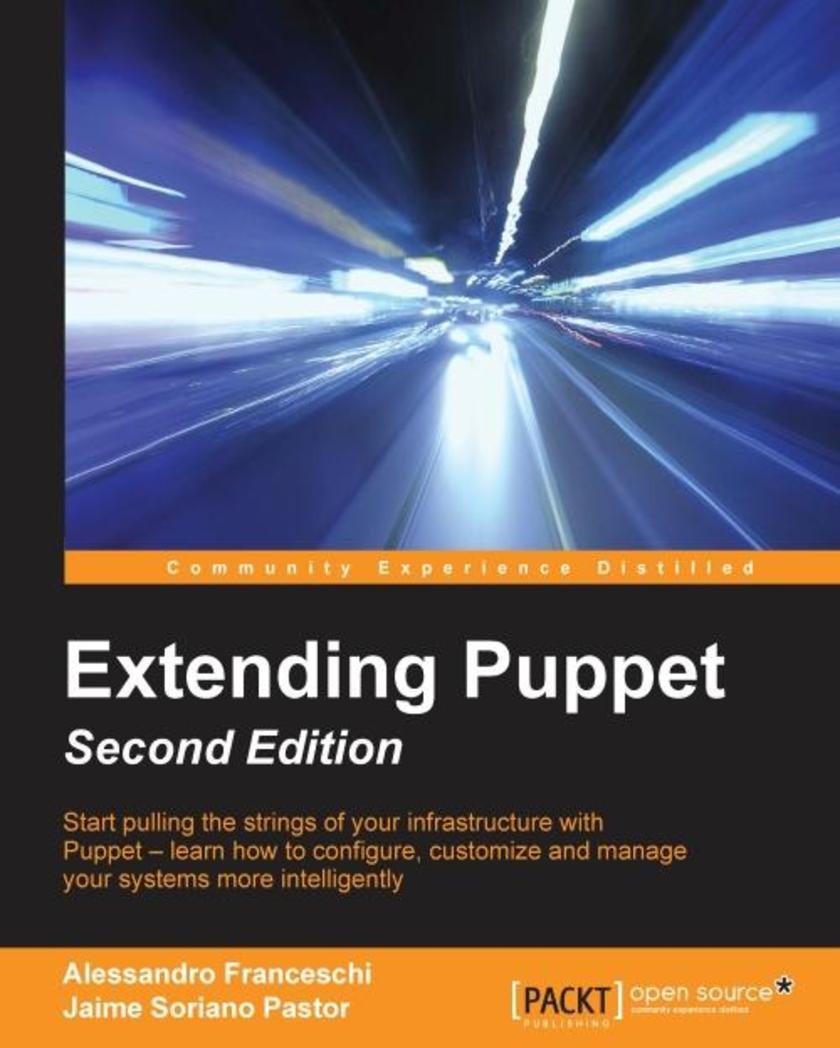
Extending Puppet - Second Edition
¥71.93
Start pulling the strings of your infrastructure with Puppet – learn how to configure, customize, and manage your systems more intelligently About This Book Explore the wider Puppet ecosystem of useful tools Design and manage your Puppet architecture for optimum performance Write more efficient code that keeps your infrastructure more robust Who This Book Is For If you are a Puppet user, this book will help you on different levels. If you a beginner, we summarize the key Puppet components and give you the elements to have a broader vision. For more experienced users, you will be surprised by with topics on designing, implementing, adapting, and deploying Puppet architectures. If you are expert, you will find topics and information that is rarely exposed in other books, giving you an insight into Puppet's future and its usage on alternative devices. What You Will Learn Learn the principles of Puppet language and ecosystem Extract the features of Hiera and PuppetDB’s power usage Explore the different approaches to Puppet architecture design Use Puppet to manage network, cloud, and virtualization devices Manage and test the Puppet code workflow Tweak, hack, and adapt the Puppet extension points Get a run through of the strategies and patterns to introduce Puppet automation Master the art of writing reusable modules In Detail Puppet has changed the way we manage our systems, but Puppet itself is changing and evolving, and so are the ways we are using it. To tackle our IT infrastructure challenges and avoid common errors when designing our architectures, an up-to-date, practical, and focused view of the current and future Puppet evolution is what we need. With Puppet, you define the state of your IT infrastructure, and it automatically enforces the desired state. This book will be your guide to designing and deploying your Puppet architecture. It will help you utilize Puppet to manage your IT infrastructure. Get to grips with Hiera and learn how to install and configure it, before learning best practices for writing reusable and maintainable code. You will also be able to explore the latest features of Puppet 4, before executing, testing, and deploying Puppet across your systems. As you progress, Extending Puppet takes you through higher abstraction modules, along with tips for effective code workflow management. Finally, you will learn how to develop plugins for Puppet - as well as some useful techniques that can help you to avoid common errors and overcome everyday challenges. Style and approach This is a collection of specific information about multiple topics related to Puppet and its ecosystem. Starting from a review of the very basics to more advanced topics, mixing practical advice with important theory and broader perspective, along with implementation details.
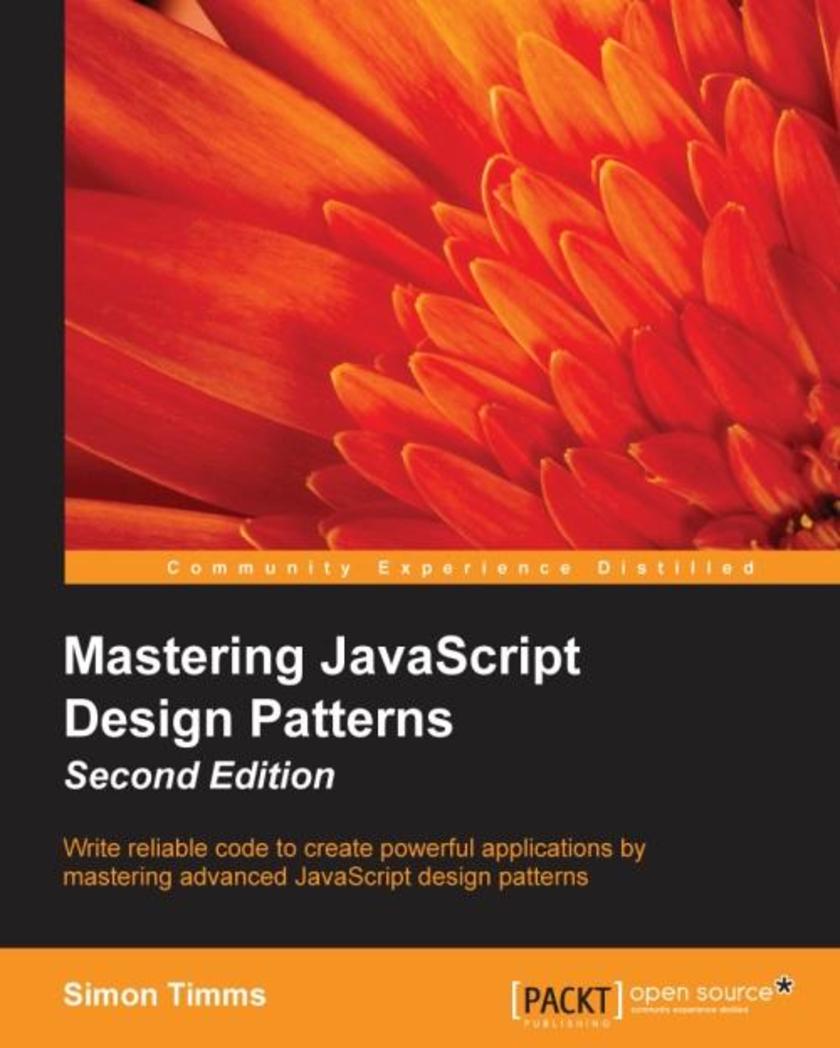
Mastering JavaScript Design Patterns - Second Edition
¥71.93
Write reliable code to create powerful applications by mastering advanced JavaScript design patterns About This Book Learn how to use tried and true software design methodologies to enhance your JavaScript code Discover robust JavaScript implementations of classic and advanced design patterns Packed with easy-to-follow examples that can be used to create reusable code and extensible designs Who This Book Is For This book is ideal for JavaScript developers who want to gain expertise in object-oriented programming with JavaScript and the new capabilities of ES-2015 to improve their web development skills and build professional-quality web applications. What You Will Learn Harness the power of patterns for tasks ranging from application building to code testing Rethink and revitalize your code with the use of functional patterns Improve the way you organize your code Build large-scale apps seamlessly with the help of reactive patterns Identify the best use cases for microservices Get to grips with creational, behavioral, and structural design patterns Explore advanced design patterns including dependency injection In Detail With the recent release of ES-2015, there are several new object-oriented features and functions introduced in JavaScript. These new features enhance the capabilities of JavaScript to utilize design patterns and software design methodologies to write powerful code. Through this book, you will explore how design patterns can help you improve and organize your JavaScript code. You’ll get to grips with creational, structural and behavioral patterns as you discover how to put them to work in different scenarios. Then, you'll get a deeper look at patterns used in functional programming, as well as model view patterns and patterns to build web applications. This updated edition will also delve into reactive design patterns and microservices as they are a growing phenomenon in the world of web development. You will also find patterns to improve the testability of your code using mock objects, mocking frameworks, and monkey patching. We’ll also show you some advanced patterns including dependency injection and live post processing. By the end of the book, you'll be saved of a lot of trial and error and developmental headaches, and you will be on the road to becoming a JavaScript expert. Style and approach Packed with several real-world use cases, this book shows you through step-by-step instructions how to implement the advanced object-oriented programming features to build sophisticated web applications that promote scalability and reusability.
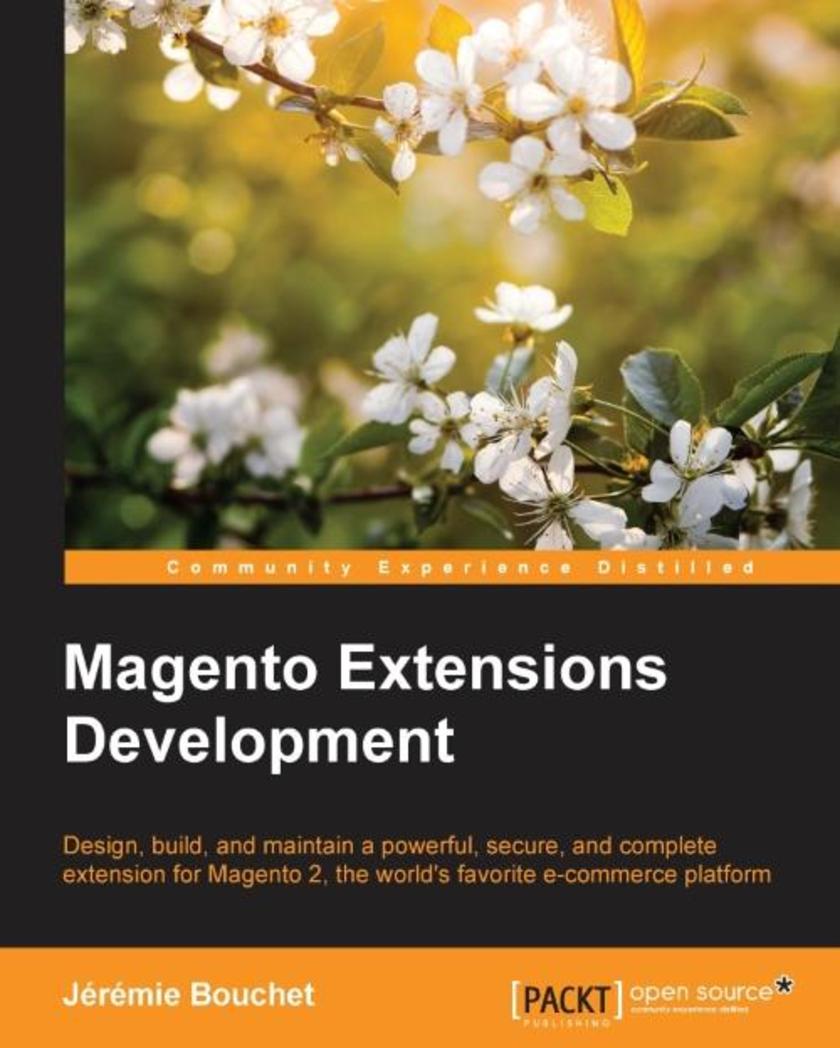
Magento Extensions Development
¥71.93
Design, build, and maintain a powerful, secure, and complete extension for Magento 2, the world’s favorite e-commerce platform About This Book Deploy a complete real-world extension step by step Construct your extension with the best and most up-to-date development methods Learn about team working and code sharing Who This Book Is For If you want to write a specific customization or a large new and full-featured extension on Magento 2, this book is intended for you. You must be an intermediate to professional-level developer in PHP to appreciate this book. What You Will Learn Build a fully-functional complex extension to add new functionality to Magento Register your code with GIT and work with your team Write new layouts and templates Set up a fully configurable grid and forms in the backend Create code unit tests and run them through TDD Propose localized contents Develop optimized extensions for a high-load environment Publish extensions on the Magento Connect Marketplace In Detail Magento has been revealed as the best and the most popular open source e-commerce platform in the world, with about 250k+ online stores. Magento 2 is the most recent version of this awesome toolset: every new and modern development techniques are used to offer a real modular approach and powerful architecture. The book will support you in the writing of innovative and complex extensions. Starting from the beginning, we will cover how to set up a development environment that allows you to be really efficient in your functionality writing, including GIT registering and many other development tools. We then move on to provide a large overview of the best practices to scale your module in a high-load environment. After these foundations, you will see how to use test driven-development (TDD) and unit tests to handle your code. We then build a complex extension together, step by step, and internationally-ready. Next, you will find out how to protect the users’ data. Finally, we will take a look a publishing the extension on the new Magento Connect marketplace and how to protect your intellectual property. After you read this book, you will know everything you need to know to become an invaluable extension editor, whether it is for your customers’ needs or for your own requirements. Style and approach This book takes a step-by-step approach to developing the extension and learning the new concepts of developments. Each topic is explained sequentially in the process of creating the extension, and punctuated by detailed explanations of the features of the code.
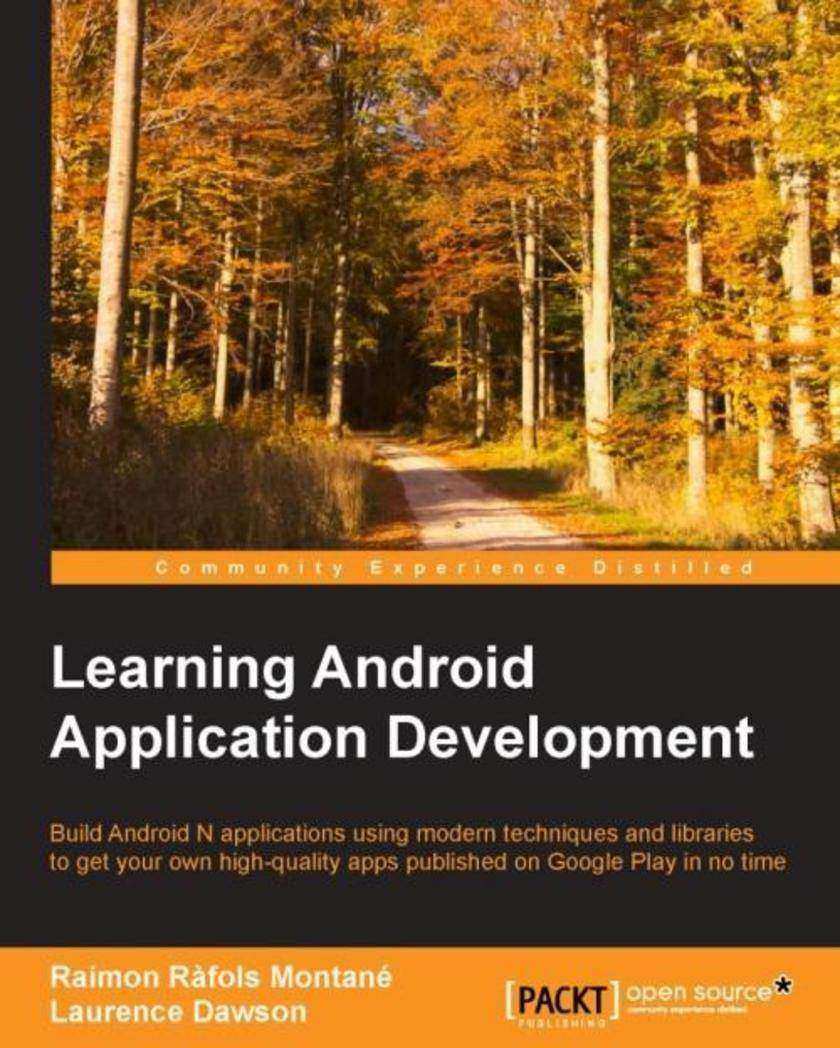
Learning Android Application Development
¥71.93
Build Android N applications using modern techniques and libraries to get your own high-quality apps published on Google Play in no time About This Book Get started with Android development, from the installation of required tools to publishing to the market Make your applications Android N ready—Android has evolved quite a lot since the very beginning and so has their Software Development Kit—so get up to speed Save time and improve the quality of your applications with widely used open source libraries and dependency management Who This Book Is For Want to get started with Android developmentStart here. What You Will Learn Get to know how to use popular open source libraries to reduce time to market and avoid re-inventing the wheel Automate your application’s testing phase to avoid last minute crashes Use dependency management to properly keep dependencies and updates under control Efficiently show huge amounts of items in a list Forget about memory and speed concerns Publish and monetize your Android applications on Google Play Persist your application data so it can continue working in offline mode Don’t let the UX break because of network issues In Detail The mobile app market is huge. But where do you startAnd how you can deliver something that takes Google Play by stormThis guide is the perfect route into Android app development – while it’s easy for new apps to sink without a trace, we’ll give you the best chance of success with practical and actionable guidance that will unlock your creativity and help you put the principles of Android development into practice. From the fundamentals and getting your project started to publishing your app to a huge market of potential customers, follow this guide to become a confident, creative and reliable mobile developer. Get to grips with new components in Android 7 such as RecyclerView, and find out how to take advantage of automated testing, and, of course, much, much more. What are you waiting forThere’s never been a better time – or a better way – to get into Android app development. Style and approach More than just a manual, this is an accessible route into Android development. Packed with examples that demonstrate how to put key concepts and ideas into practice, this guide isn’t just about learning, it’s about immediate development.
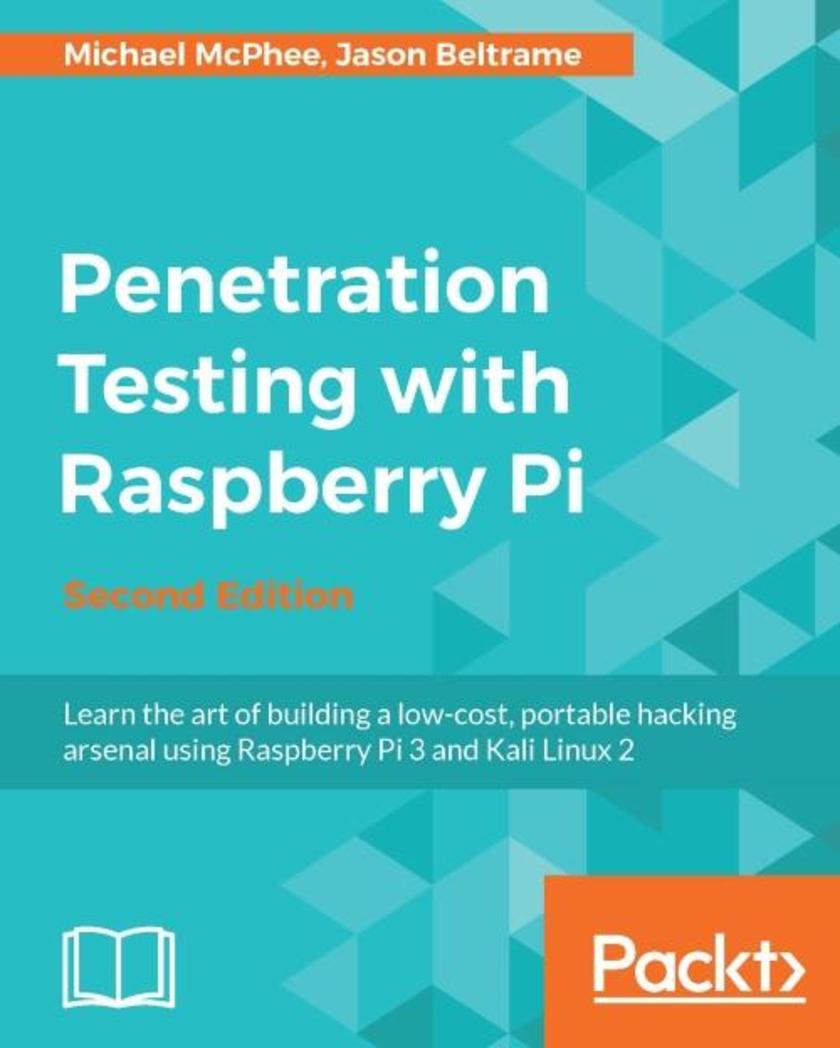
Penetration Testing with Raspberry Pi - Second Edition
¥71.93
Learn the art of building a low-cost, portable hacking arsenal using Raspberry Pi 3 and Kali Linux 2 About This Book Quickly turn your Raspberry Pi 3 into a low-cost hacking tool using Kali Linux 2 Protect your confidential data by deftly preventing various network security attacks Use Raspberry Pi 3 as honeypots to warn you that hackers are on your wire Who This Book Is For If you are a computer enthusiast who wants to learn advanced hacking techniques using the Raspberry Pi 3 as your pentesting toolbox, then this book is for you. Prior knowledge of networking and Linux would be an advantage. What You Will Learn Install and tune Kali Linux 2 on a Raspberry Pi 3 for hacking Learn how to store and offload pentest data from the Raspberry Pi 3 Plan and perform man-in-the-middle attacks and bypass advanced encryption techniques Compromise systems using various exploits and tools using Kali Linux 2 Bypass security defenses and remove data off a target network Develop a command and control system to manage remotely placed Raspberry Pis Turn a Raspberry Pi 3 into a honeypot to capture sensitive information In Detail This book will show you how to utilize the latest credit card sized Raspberry Pi 3 and create a portable, low-cost hacking tool using Kali Linux 2. You’ll begin by installing and tuning Kali Linux 2 on Raspberry Pi 3 and then get started with penetration testing. You will be exposed to various network security scenarios such as wireless security, scanning network packets in order to detect any issues in the network, and capturing sensitive data. You will also learn how to plan and perform various attacks such as man-in-the-middle, password cracking, bypassing SSL encryption, compromising systems using various toolkits, and many more. Finally, you’ll see how to bypass security defenses and avoid detection, turn your Pi 3 into a honeypot, and develop a command and control system to manage a remotely-placed Raspberry Pi 3. By the end of this book you will be able to turn Raspberry Pi 3 into a hacking arsenal to leverage the most popular open source toolkit, Kali Linux 2.0. Style and approach This concise and fast-paced guide will ensure you get hands-on with penetration testing right from the start. You will quickly install the powerful Kali Linux 2 on your Raspberry Pi 3 and then learn how to use and conduct fundamental penetration techniques and attacks.
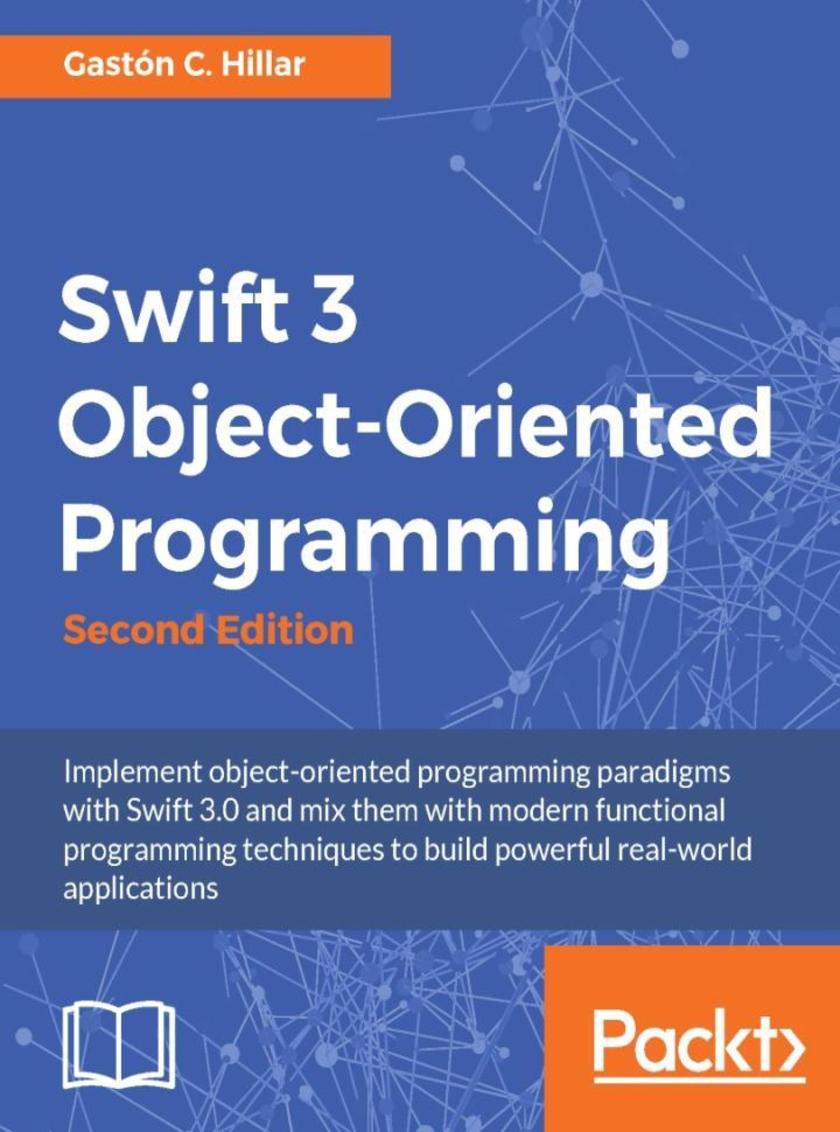
Swift 3 Object-Oriented Programming - Second Edition
¥71.93
Implement object-oriented programming paradigms with Swift 3.0 and mix them with modern functional programming techniques to build powerful real-world applications About This Book Leverage the most efficient object-oriented design patterns in your Swift applications Write robust, safer, and better code using the blueprints that generate objects Build a platform with object-oriented code using real-world elements and represent them in your apps Who This Book Is For This book is for iOS and macOS developers who want to get a detailed practical understanding of object-oriented programming with the latest version of Swift: 3.0. What You Will Learn Write high-quality and easy-to-maintain reusable object-oriented code to build applications for iOS, macOS, and Linux Work with encapsulation, abstraction, and polymorphism using Swift 3.0 Work with classes, instances, properties, and methods in Swift 3.0 Take advantage of inheritance, specialization, and the possibility to overload or override members Implement encapsulation, abstraction, and polymorphism Explore functional programming techniques mixed with object-oriented code in Swift 3.0 Understand the differences between Swift 3.0, previous Swift versions, and Objective-C code In Detail Swift has quickly become one of the most-liked languages and developers’ de-facto choice when building applications that target iOS and macOS. In the new version, the Swift team wants to take its adoption to the next level by making it available for new platforms and audiences. This book introduces the object-oriented paradigm and its implementation in the Swift 3 programming language to help you understand how real-world objects can become part of fundamental reusable elements in the code. This book is developed with XCode 8.x and covers all the enhancements included in Swift 3.0. In addition, we teach you to run most of the examples with the Swift REPL available on macOS and Linux, and with a Web-based Swift sandbox developed by IBM capable of running on any web browser, including Windows and mobile devices. You will organize data in blueprints that generate instances. You’ll work with examples so you understand how to encapsulate and hide data by working with properties and access control. Then, you’ll get to grips with complex scenarios where you use instances that belong to more than one blueprint. You’ll discover the power of contract programming and parametric polymorphism. You’ll combine generic code with inheritance and multiple inheritance. Later, you’ll see how to combine functional programming with object-oriented programming and find out how to refactor your existing code for easy maintenance. Style and approach This simple guide is packed with practical examples of solutions to common problems. Each chapter includes exercises and the possibility for you to test your progress by answering a quiz
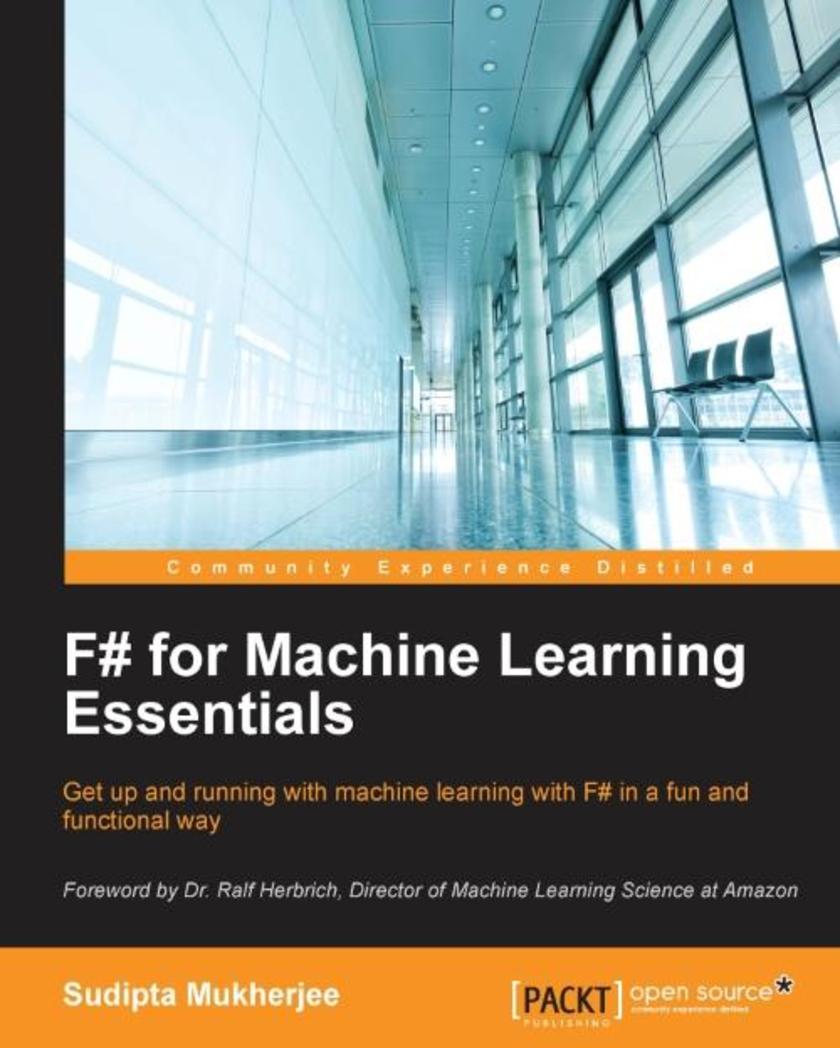
F# for Machine Learning Essentials
¥71.93
Get up and running with machine learning with F# in a fun and functional wayAbout This BookDesign algorithms in F# to tackle complex computing problemsBe a proficient F# data scientist using this simple-to-follow guideSolve real-world, data-related problems with robust statistical models, built for a range of datasetsWho This Book Is ForIf you are a C# or an F# developer who now wants to explore the area of machine learning, then this book is for you. Familiarity with theoretical concepts and notation of mathematics and statistics would be an added advantage.What You Will LearnUse F# to find patterns through raw dataBuild a set of classification systems using Accord.NET, Weka, and F#Run machine learning jobs on the Cloud with MBracePerform mathematical operations on matrices and vectors using Math.NETUse a recommender system for your own problem domainIdentify tourist spots across the globe using inputs from the user with decision tree algorithmsIn DetailThe F# functional programming language enables developers to write simple code to solve complex problems. With F#, developers create consistent and predictable programs that are easier to test and reuse, simpler to parallelize, and are less prone to bugs.If you want to learn how to use F# to build machine learning systems, then this is the book you want.Starting with an introduction to the several categories on machine learning, you will quickly learn to implement time-tested, supervised learning algorithms. You will gradually move on to solving problems on predicting housing pricing using Regression Analysis. You will then learn to use Accord.NET to implement SVM techniques and clustering. You will also learn to build a recommender system for your e-commerce site from scratch. Finally, you will dive into advanced topics such as implementing neural network algorithms while performing sentiment analysis on your data.Style and approachThis book is a fast-paced tutorial guide that uses hands-on examples to explain real-world applications of machine learning. Using practical examples, the book will explore several machine learning techniques and also describe how you can use F# to build machine learning systems.
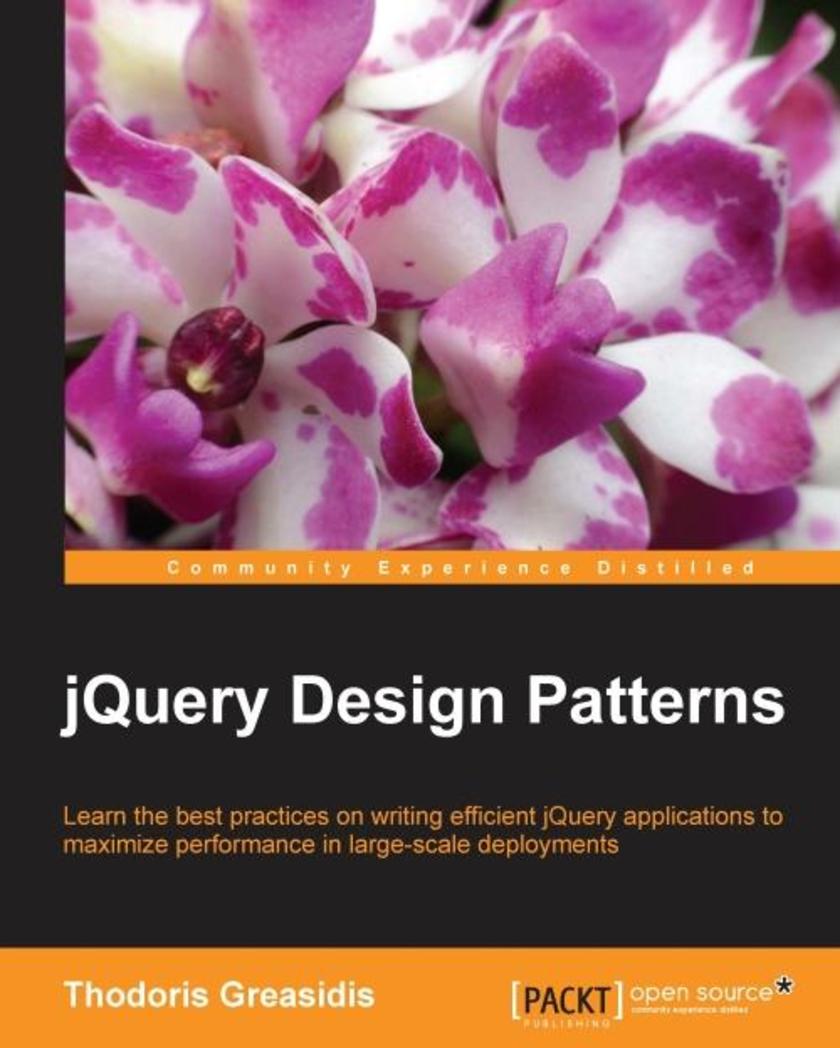
jQuery Design Patterns
¥71.93
Learn the best practices on writing efficient jQuery applications to maximize performance in large-scale deploymentsAbout This BookLearn about the observer pattern and the deferred observer pattern, two of the most popular design patterns that handle custom eventsAdvance your jQuery skills by learning about patterns such as divide and conquer, facade, and builder and factory to handle complex resultsThis step-by-step guide to applying micro-patterns and optimizing jQuery applications will help you get the best performance in a production environmentWho This Book Is ForThis book is for existing jQuery Developers or new developers who want to get an understanding of the “correct way” to build jQuery applications, using best practices and industry standard patterns.What You Will LearnRespond to user actionsAchieve greater flexibility and code decouplingHave a central point for emitting and receiving application level eventsStructure the application into small independent modulesAbstract complex APIsIsolate the procedure of generating complex parts of the applicationEfficiently orchestrate asynchronous procedures using jQuery Deferred and PromisesUtilize the most widely-used client-side templating libraries for more complex use casesIn DetailjQuery is a feature-rich JavaScript library that makes HTML document traversal and manipulation, event handling, animation, and Ajax much simpler with an easy-to-use API that works across a variety of browsers. With a combination of versatility and extensibility, jQuery has changed the way that millions of people write JavaScript.jQuery solves the problems of DOM manipulation, event detection, AJAX calls, element selection and document queries, element attribute and data management, as well as object management utilities. This book addresses these problems and shows you how to make the best of jQuery through the various design patterns available.The book starts off with a refresher to jQuery and will then take you through the different design patterns such as facade, observer, publisher/subscriber, and so on. We will also go into client-side templating techniques and libraries, as well as some plugin development patterns. Finally, we will look into some best practices that you can use to make the best of jQuery.Style and approachThe example-oriented guide covers the best and most widely used patterns to help you improve your development with jQuery.
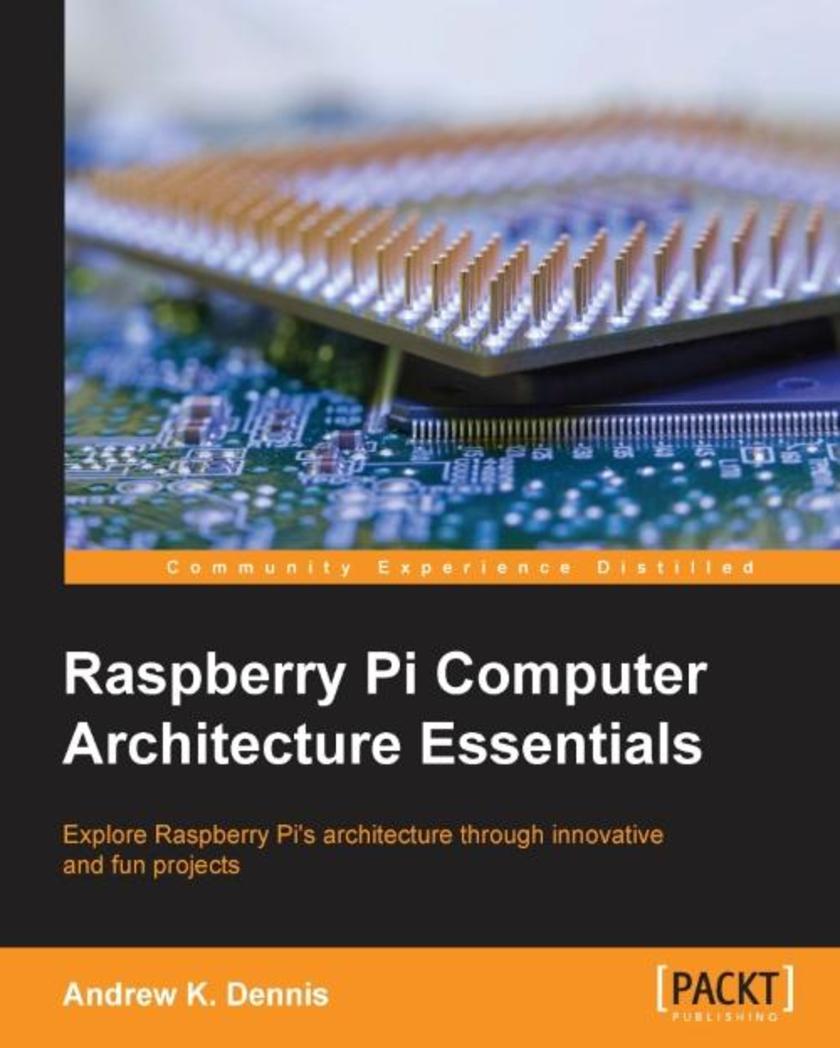
Raspberry Pi Computer Architecture Essentials
¥71.93
Explore Raspberry Pi's architecture through innovative and fun projects About This Book Explore Raspberry Pi 2’s hardware through the Assembly, C/C++, and Python programming languages Experiment with connecting electronics up to your Raspberry Pi 2 and interacting with them through software Learn about the Raspberry Pi 2 architecture and Raspbian operating system through innovative projects Who This Book Is For Raspberry Pi Computer Architecture Essentials is for those who are new and those who are familiar with the Raspberry Pi. Each topic builds upon earlier ones to provide you with a guide to Raspberry Pi’s architecture. From the novice to the expert, there is something for everyone. A basic knowledge of programming and Linux would be helpful but is not required. What You Will Learn Set up your Raspberry Pi 2 and learn about its hardware Write basic programs in Assembly Language to learn about the ARM architecture Use C and C++ to interact with electronic components Find out about the Python language and how to use it to build web applications Interact with third-party microcontrollers Experiment with graphics and audio programming Expand Raspberry Pi 2’s storage mechanism by using external devices Discover Raspberry Pi 2’s GPIO pins and how to interact with them In Detail With the release of the Raspberry Pi 2, a new series of the popular compact computer is available for you to build cheap, exciting projects and learn about programming. In this book, we explore Raspberry Pi 2’s hardware through a number of projects in a variety of programming languages. We will start by exploring the various hardware components in detail, which will provide a base for the programming projects and guide you through setting up the tools for Assembler, C/C++, and Python. We will then learn how to write multi-threaded applications and Raspberry Pi 2’s multi-core processor. Moving on, you’ll get hands on by expanding the storage options of the Raspberry Pi beyond the SD card and interacting with the graphics hardware. Furthermore, you will be introduced to the basics of sound programming while expanding upon your knowledge of Python to build a web server. Finally, you will learn to interact with the third-party microcontrollers. From writing your first Assembly Language application to programming graphics, this title guides you through the essentials. Style and approach This book takes a step-by-step approach to exploring Raspberry Pi’s architecture through projects that build upon each other. Each project provides you with new information on how to interact with an aspect of the Raspberry Pi and Raspbian operating system, providing a well-rounded guide.
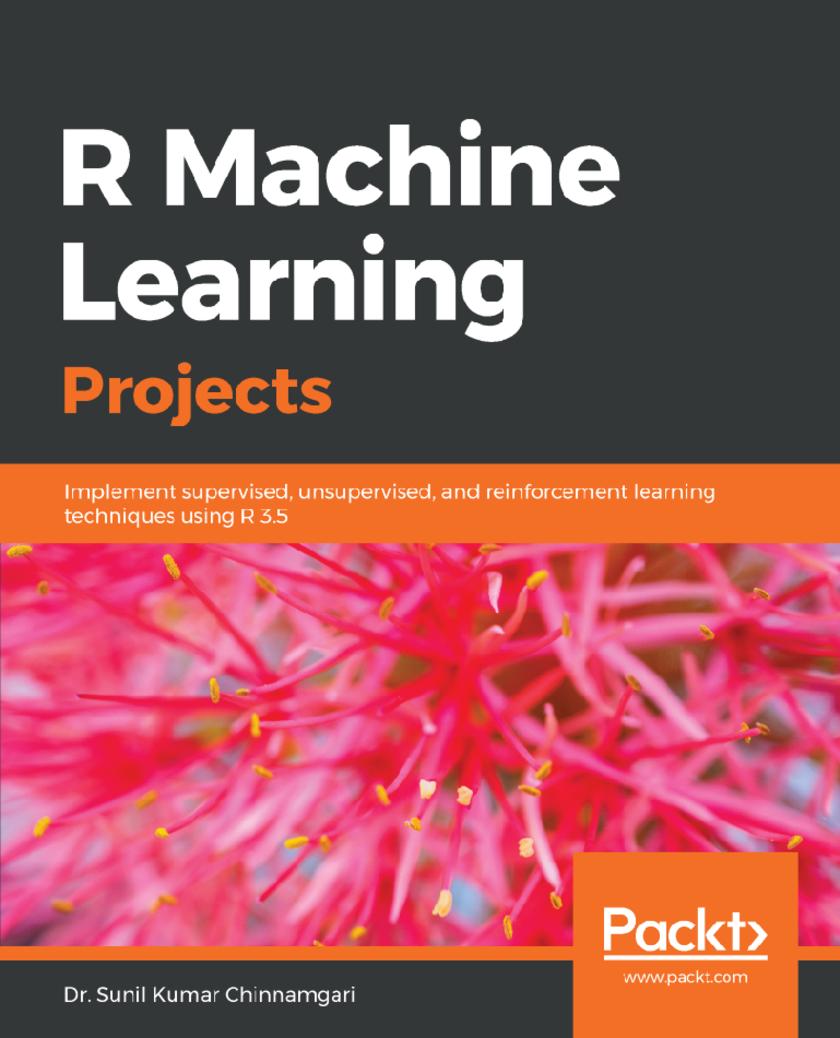
R Machine Learning Projects
¥71.93
Master a range of machine learning domains with real-world projects using TensorFlow for R, H2O, MXNet, and more Key Features *Master machine learning, deep learning, and predictive modeling concepts in R 3.5 *Build intelligent end-to-end projects for finance, retail, social media, and a variety of domains *Implement smart cognitive models with helpful tips and best practices Book Description R is one of the most popular languages when it comes to performing computational statistics (statistical computing) easily and exploring the mathematical side of machine learning. With this book, you will leverage the R ecosystem to build efficient machine learning applications that carry out intelligent tasks within your organization. This book will help you test your knowledge and skills, guiding you on how to build easily through to complex machine learning projects. You will first learn how to build powerful machine learning models with ensembles to predict employee attrition. Next, you’ll implement a joke recommendation engine and learn how to perform sentiment analysis on Amazon reviews. You’ll also explore different clustering techniques to segment customers using wholesale data. In addition to this, the book will get you acquainted with credit card fraud detection using autoencoders, and reinforcement learning to make predictions and win on a casino slot machine. By the end of the book, you will be equipped to confidently perform complex tasks to build research and commercial projects for automated operations. What you will learn *Explore deep neural networks and various frameworks that can be used in R *Develop a joke recommendation engine to recommend jokes that match users’ tastes *Create powerful ML models with ensembles to predict employee attrition *Build autoencoders for credit card fraud detection *Work with image recognition and convolutional neural networks *Make predictions for casino slot machine using reinforcement learning *Implement NLP techniques for sentiment analysis and customer segmentation Who this book is for If you’re a data analyst, data scientist, or machine learning developer who wants to master machine learning concepts using R by building real-world projects, this is the book for you. Each project will help you test your skills in implementing machine learning algorithms and techniques. A basic understanding of machine learning and working knowledge of R programming is necessary to get the most out of this book.
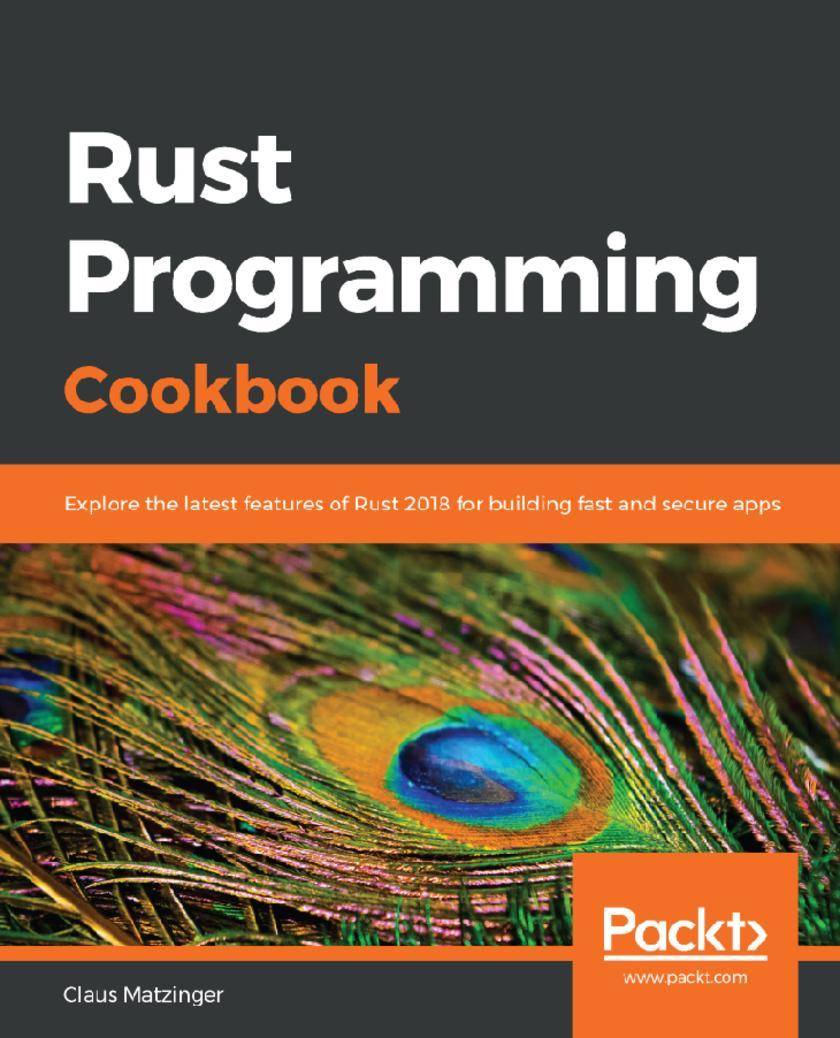
Rust Programming Cookbook
¥71.93
Practical solutions to overcome challenges in creating console and web applications and working with systems-level and embedded code, network programming, deep neural networks, and much more. Key Features * Work through recipes featuring advanced concepts such as concurrency, unsafe code, and macros to migrate your codebase to the Rust programming language * Learn how to run machine learning models with Rust * Explore error handling, macros, and modularization to write maintainable code Book Description Rust 2018, Rust's first major milestone since version 1.0, brings more advancement in the Rust language. The Rust Programming Cookbook is a practical guide to help you overcome challenges when writing Rust code. This Rust book covers recipes for configuring Rust for different environments and architectural designs, and provides solutions to practical problems. It will also take you through Rust's core concepts, enabling you to create efficient, high-performance applications that use features such as zero-cost abstractions and improved memory management. As you progress, you'll delve into more advanced topics, including channels and actors, for building scalable, production-grade applications, and even get to grips with error handling, macros, and modularization to write maintainable code. You will then learn how to overcome common roadblocks when using Rust for systems programming, IoT, web development, and network programming. Finally, you'll discover what Rust 2018 has to offer for embedded programmers. By the end of the book, you'll have learned how to build fast and safe applications and services using Rust. What you will learn * Understand how Rust provides unique solutions to solve system programming language problems * Grasp the core concepts of Rust to develop fast and safe applications * Explore the possibility of integrating Rust units into existing applications for improved efficiency * Discover how to achieve better parallelism and security with Rust * Write Python extensions in Rust * Compile external assembly files and use the Foreign Function Interface (FFI) * Build web applications and services using Rust for high performance Who this book is for The Rust cookbook is for software developers looking to enhance their knowledge of Rust and leverage its features using modern programming practices. Familiarity with Rust language is expected to get the most out of this book.
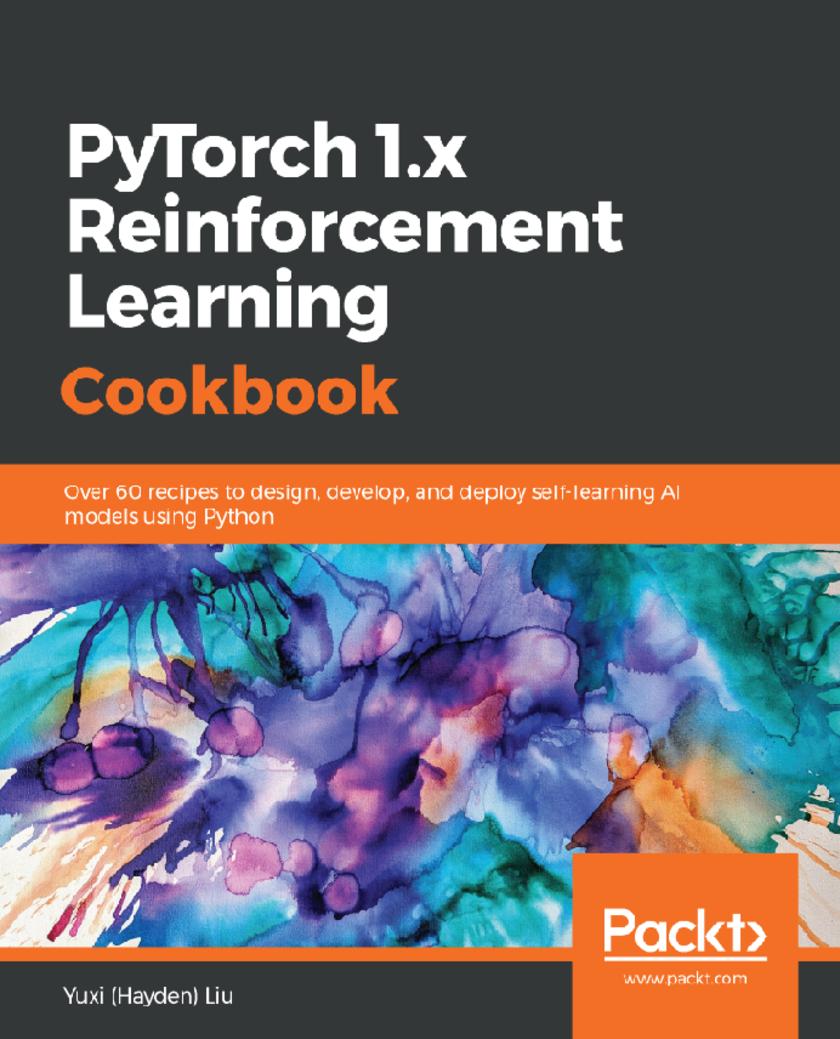
PyTorch 1.x Reinforcement Learning Cookbook
¥71.93
Implement reinforcement learning techniques and algorithms with the help of real-world examples and recipes Key Features * Use PyTorch 1.x to design and build self-learning artificial intelligence (AI) models * Implement RL algorithms to solve control and optimization challenges faced by data scientists today * Apply modern RL libraries to simulate a controlled environment for your projects Book Description Reinforcement learning (RL) is a branch of machine learning that has gained popularity in recent times. It allows you to train AI models that learn from their own actions and optimize their behavior. PyTorch has also emerged as the preferred tool for training RL models because of its efficiency and ease of use. With this book, you'll explore the important RL concepts and the implementation of algorithms in PyTorch 1.x. The recipes in the book, along with real-world examples, will help you master various RL techniques, such as dynamic programming, Monte Carlo simulations, temporal difference, and Q-learning. You'll also gain insights into industry-specific applications of these techniques. Later chapters will guide you through solving problems such as the multi-armed bandit problem and the cartpole problem using the multi-armed bandit algorithm and function approximation. You'll also learn how to use Deep Q-Networks to complete Atari games, along with how to effectively implement policy gradients. Finally, you'll discover how RL techniques are applied to Blackjack, Gridworld environments, internet advertising, and the Flappy Bird game. By the end of this book, you'll have developed the skills you need to implement popular RL algorithms and use RL techniques to solve real-world problems. What you will learn * Use Q-learning and the state–action–reward–state–action (SARSA) algorithm to solve various Gridworld problems * Develop a multi-armed bandit algorithm to optimize display advertising * Scale up learning and control processes using Deep Q-Networks * Simulate Markov Decision Processes, OpenAI Gym environments, and other common control problems * Select and build RL models, evaluate their performance, and optimize and deploy them * Use policy gradient methods to solve continuous RL problems Who this book is for Machine learning engineers, data scientists and AI researchers looking for quick solutions to different reinforcement learning problems will find this book useful. Although prior knowledge of machine learning concepts is required, experience with PyTorch will be useful but not necessary.
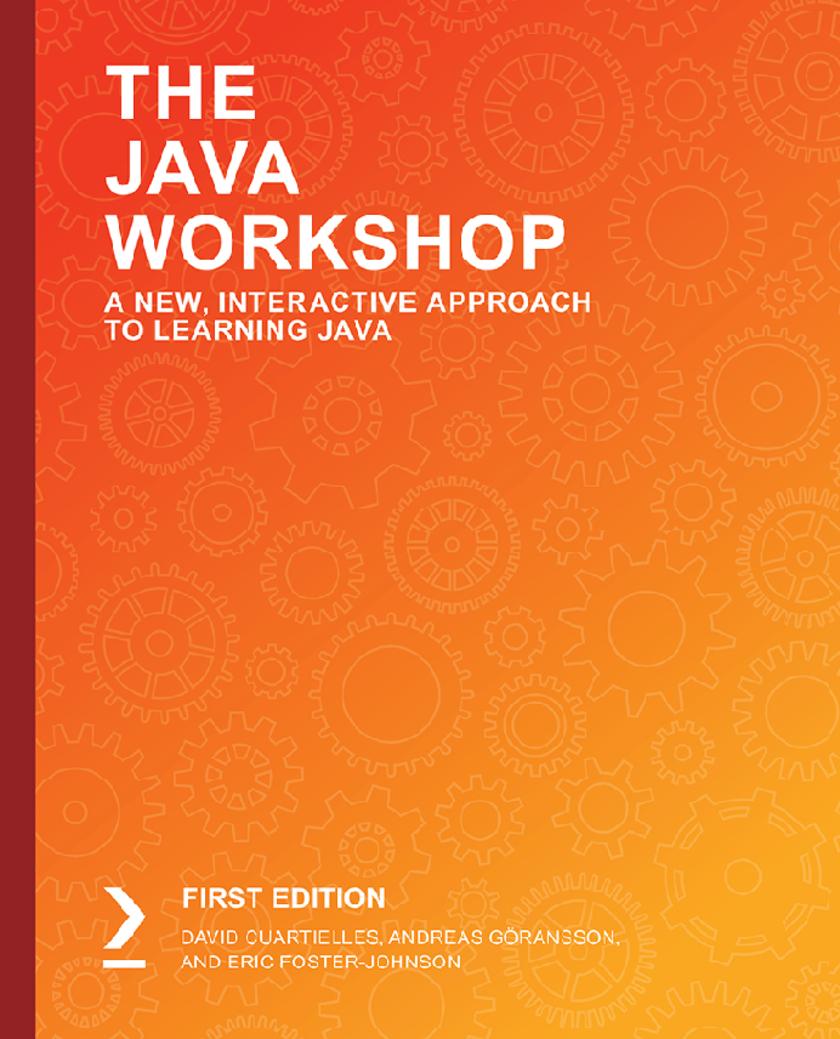
The Java Workshop
¥71.93
Cut through the noise and get real results with a step-by-step approach to learning Java programming Key Features * Ideal for the Java beginner who is getting started for the first time * A step-by-step Java tutorial with exercises and activities that help build key skills * Structured to let you progress at your own pace, on your own terms * Use your physical copy to redeem free access to the online interactive edition Book Description You already know you want to learn Java, and a smarter way to learn Java 12 is to learn by doing. The Java Workshop focuses on building up your practical skills so that you can develop high-performance Java applications that work flawlessly within the JVM across web, mobile and desktop. You'll learn from real examples that lead to real results. Throughout The Java Workshop, you'll take an engaging step-by-step approach to understanding Java. You won't have to sit through any unnecessary theory. If you're short on time you can jump into a single exercise each day or spend an entire weekend learning about Reactive programming and Unit testing. It's your choice. Learning on your terms, you'll build up and reinforce key skills in a way that feels rewarding. Every physical copy of The Java Workshop unlocks access to the interactive edition. With videos detailing all exercises and activities, you'll always have a guided solution. You can also benchmark yourself against assessments, track progress, and receive free content updates. You'll even earn a secure credential that you can share and verify online upon completion. It's a premium learning experience that's included with your printed copy. To redeem, follow the instructions located at the start of your Java book. Fast-paced and direct, The Java Workshop is the ideal companion for Java beginners. You'll build and iterate on your code like a software developer, learning along the way. This process means that you'll find that your new skills stick, embedded as best practice. A solid foundation for the years ahead. What you will learn * Get to grips with fundamental concepts and conventions of Java 12 * Write clean and well-commented code that's easy to maintain * Debug and compile logical errors and handle exceptions in your programs * Understand how to work with Java APIs and Java streams * Learn how to use third-party libraries and software development kits (SDKs) * Discover how you can work with information stored in databases * Understand how you can keep data secure with cryptography and encryption * Learn how to keep your development process bug-free with unit testing in Java Who this book is for Our goal at Packt is to help you be successful, in whatever it is you choose to do. The Java Workshop is an ideal Java tutorial for the Java beginner who is just getting started. Pick up a Workshop today, and let Packt help you develop skills that stick with you for life.
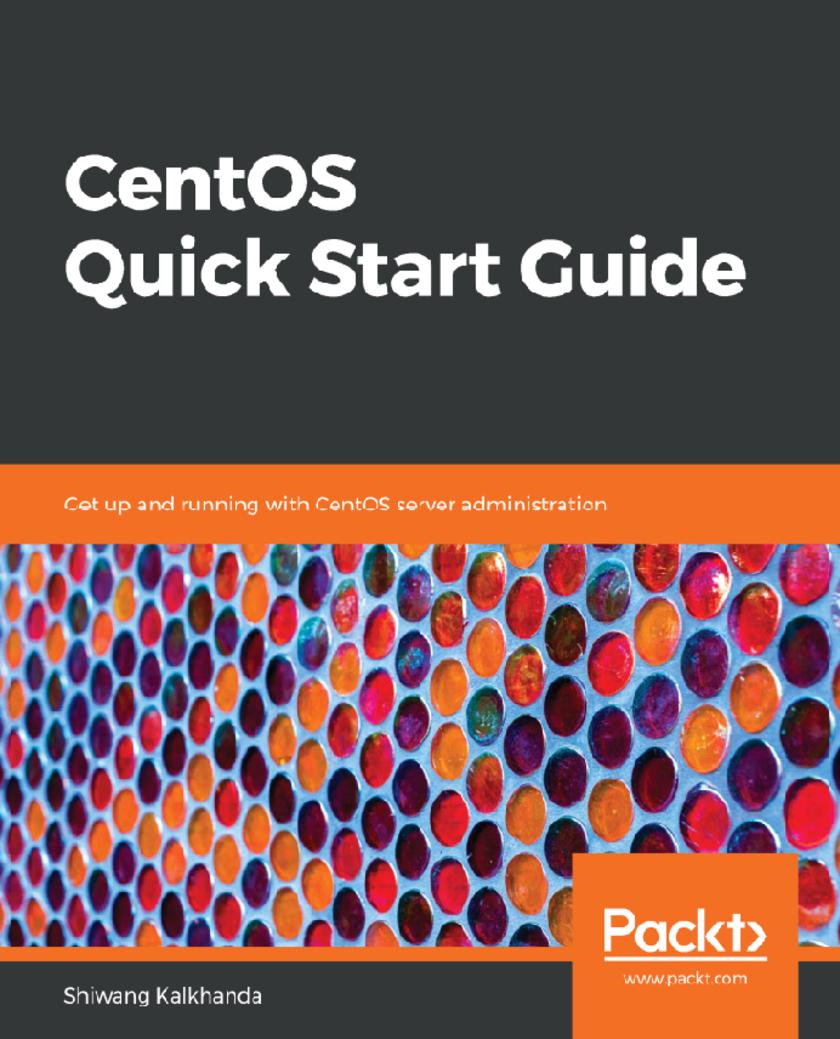
CentOS Quick Start Guide
¥71.93
A concise walk-through of CentOS 7, starting from installation to securing it’s environment. Key Features *No previous Linux environment experience needed for reading this book *Get comfortable with a popular and stable Red Hat Enterprise Linux distribution *Most of the command line based concepts are explained with graphics Book Description Linux kernel development has been the worlds largest collaborative project to date. With this practical guide, you will learn Linux through one of its most popular and stable distributions. This book will introduce you to essential Linux skills using CentOS 7. It describes how a Linux system is organized, and will introduce you to key command-line concepts you can practice on your own. It will guide you in performing basic system administration tasks and day-to-day operations in a Linux environment. You will learn core system administration skills for managing a system running CentOS 7 or a similar operating system, such as RHEL 7, Scientific Linux, and Oracle Linux. You will be able to perform installation, establish network connectivity and user and process management, modify file permissions, manage text files using the command line, and implement basic security administration after covering this book. By the end of this book, you will have a solid understanding of working with Linux using the command line. What you will learn *Understand file system hierarchy and essential command-line skills *Use Vi editor, I/O redirections and how to work with common text manipulating tools *Create, delete, modify user accounts and manage passwords and their aging policy *Manage file ownership, permissions, and ACL *Execute process management and monitoring on the command line *Validate and manage network configuration using nmcli *Manage remote logins using SSH and file transfer using SCP and Rsync *Understand system logging, how to control system services with systemd and systemctl, and manage firewalId Who this book is for Any individual who wants to learn how to use Linux as server or desktop in his environment. Whether you are a developer, budding system administrator, or tech lover with no previous Linux administration background, you will be able to start your journey in Linux using CentOS 7 with this book.
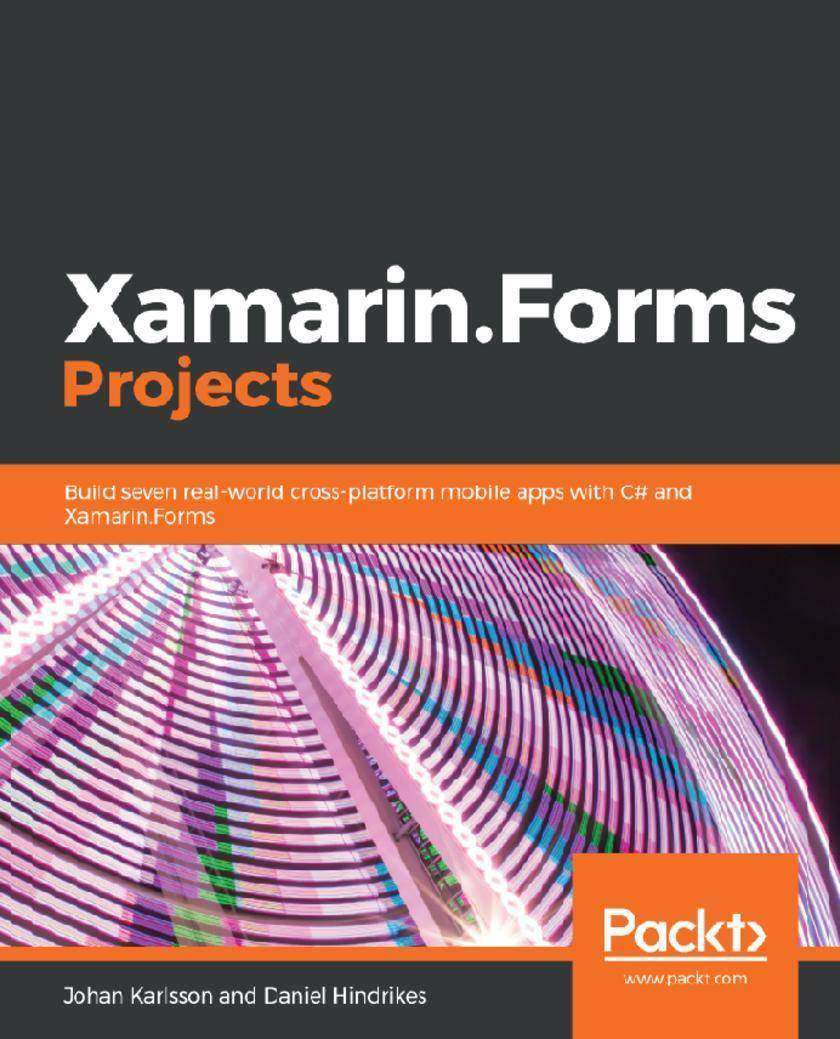
Xamarin.Forms Projects
¥71.93
Explore Xamarin.Forms to develop dynamic applications Key Features *Explore SQLite through Xamarin to store locations for various location-based applications *Make a real-time serverless chat service by using Azure SignalR service *Build Augmented Reality application with the power of UrhoSharp together with ARKit and ARCore Book Description Xamarin.Forms is a lightweight cross-platform development toolkit for building applications with a rich user interface. In this book you'll start by building projects that explain the Xamarin.Forms ecosystem to get up and running with building cross-platform applications. We'll increase in difficulty throughout the projects, making you learn the nitty-gritty of Xamarin.Forms offerings. You'll gain insights into the architecture, how to arrange your app's design, where to begin developing, what pitfalls exist, and how to avoid them. The book contains seven real-world projects, to get you hands-on with building rich UIs and providing a truly cross-platform experience. It will also guide you on how to set up a machine for Xamarin app development. You'll build a simple to-do application that gets you going, then dive deep into building advanced apps such as messaging platform, games, and machine learning, to build a UI for an augmented reality project. By the end of the book, you'll be confident in building cross-platforms and fitting Xamarin.Forms toolkits in your app development. You'll be able to take the practice you get from this book to build applications that comply with your requirements. What you will learn *Set up a machine for Xamarin development *Get to know about MVVM and data bindings in Xamarin.Forms *Understand how to use custom renderers to gain platform-specific access *Discover Geolocation services through Xamarin Essentials *Create an abstraction of ARKit and ARCore to expose as a single API for the game *Learn how to train a model for image *classification with Azure Cognitive Services Who this book is for This book is for mobile application developers who want to start building native mobile apps using the powerful Xamarin.Forms and C#. Working knowledge of C#, .NET, and Visual Studio is required.
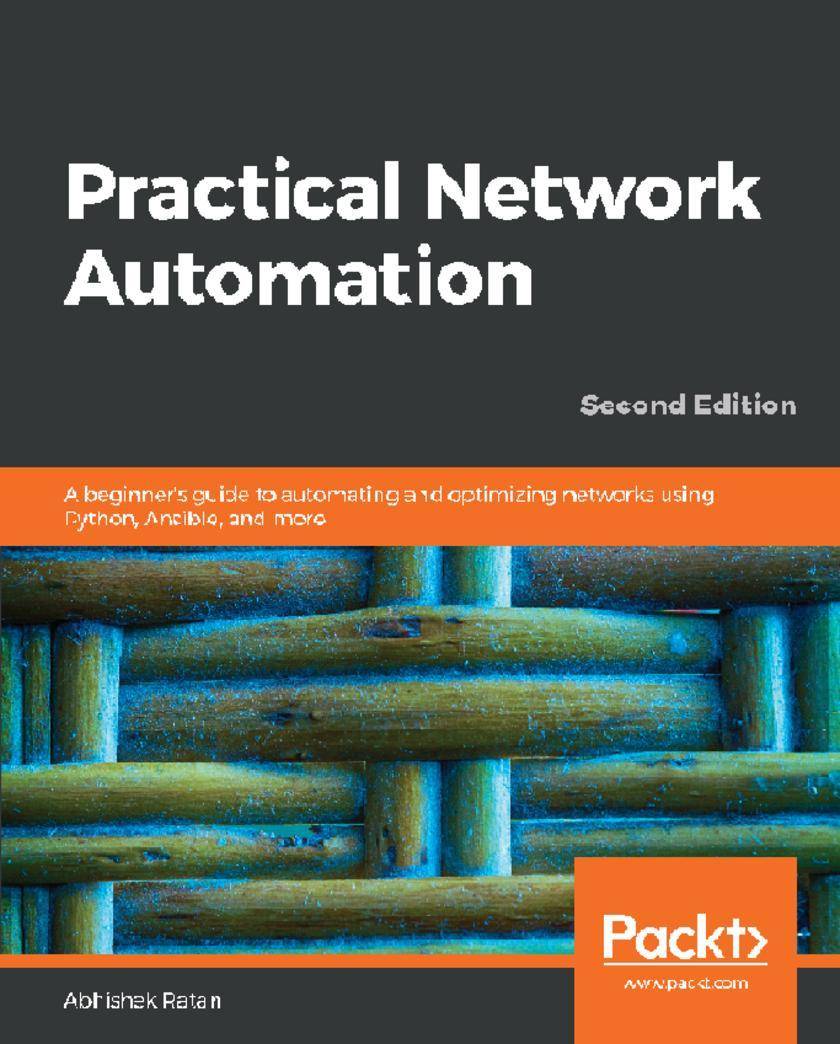
Practical Network Automation
¥71.93
Leverage the power of Python, Ansible and other network automation tools to make your network robust and more secure Key Features *Get introduced to the concept of network automation with relevant use cases *Apply Continuous Integration and DevOps to improve your network performance *Implement effective automation using tools such as Python, Ansible, and more Book Description Network automation is the use of IT controls to supervise and carry out everyday network management functions. It plays a key role in network virtualization technologies and network functions. The book starts by providing an introduction to network automation, and its applications, which include integrating DevOps tools to automate the network efficiently. It then guides you through different network automation tasks and covers various data digging and performing tasks such as ensuring golden state configurations using templates, interface parsing. This book also focuses on Intelligent Operations using Artificial Intelligence and troubleshooting using chatbots and voice commands. The book then moves on to the use of Python and the management of SSH keys for machine-to-machine (M2M) communication, all followed by practical use cases. The book also covers the importance of Ansible for network automation, including best practices in automation; ways to test automated networks using tools such as Puppet, SaltStack, and Chef; and other important techniques. Through practical use-cases and examples, this book will acquaint you with the various aspects of network automation. It will give you the solid foundation you need to automate your own network without any hassle. What you will learn *Get started with the fundamental concepts of network automation *Perform intelligent data mining and remediation based on triggers *Understand how AIOps works in operations *Trigger automation through data factors *Improve your data center's robustness and security through data digging *Get access infrastructure through API Framework for chatbot and voice interactive troubleshootings *Set up communication with SSH-based devices using Netmiko Who this book is for If you are a network engineer or a DevOps professional looking for an extensive guide to help you automate and manage your network efficiently, then this book is for you. No prior experience with network automation is required to get started, however you will need some exposure to Python programming to get the most out of this book.




 购物车
购物车 个人中心
个人中心



